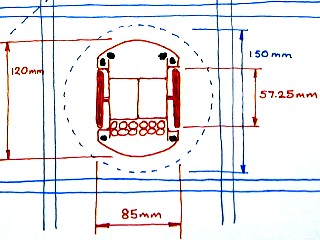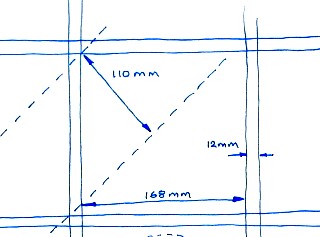Is bigger better? Probably not.
The inside dimensions of a maze cell are just 168mm square. The cells are spaced at 180mm and the walls are 12mm thick. Make yourself a single cell with life size walls. Not only has your mouse got to fit in there it has to move and manoeuvre in that tiny space. Say you find yourself at the end of a 12 cell passage and it is a dead end. You either have to back out or turn around. The clever among you may build a bi-directional mouse, do a virtual about-face and drive on. The rest of us had best turn around. We don’t really want to knock into the walls while doing it but we may not be able to guarantee our position that well. Ensure you have a healthy margin in all directions. If you ever hit a wall, you are in deep trouble. All you odometry data now becomes suspect. If the mouse cannot tell that it has hit anything, it will not know it is using suspect data. Even so, build crash recovery into your mouse software.
It may be better to accept a touch penalty and pick up your mouse, replacing it at the start, than trying to work out how to make it recover.
The entire mouse must fit into a 25cm square. While this sounds like a lot, you might want to have down-looking sensors that hang over the maze walls. Using the maximum available width allows about 35mm overhang beyond the walls on each side. This is fine if you are correctly positioned in the maze. Consider what happens if you are off centre with an offset error or have a severe heading error. How far out can you be and still have the ability to detect one or both walls. If you can’t do that then you can’t correct your error. The section on sensors has more to say on this.
Since excessive size carries a serious performance penalty for a racing mouse, there are those who think that the size limit should be scrapped as it has no point.
Here are some drawings showing he key domensions you will be working to:

